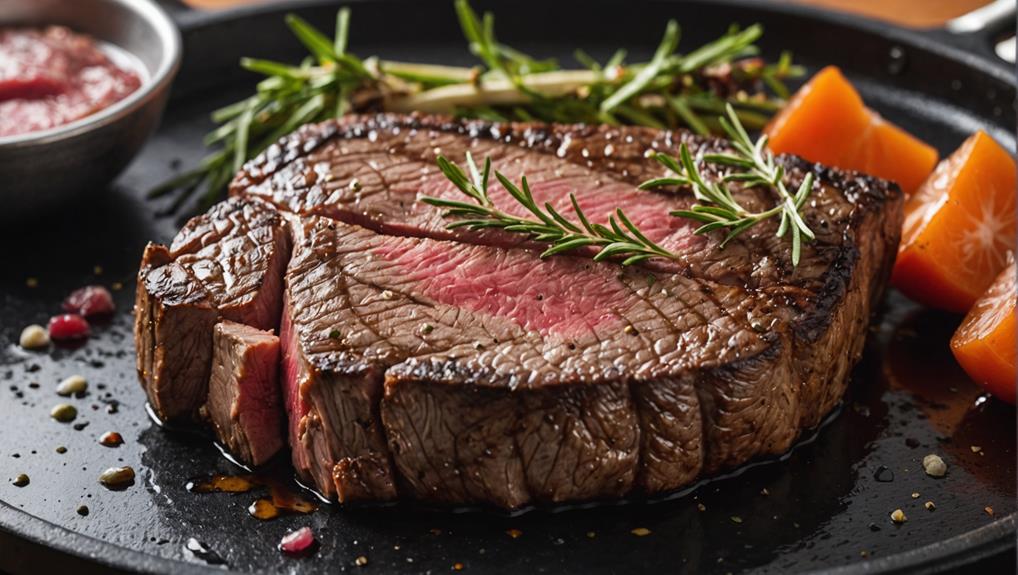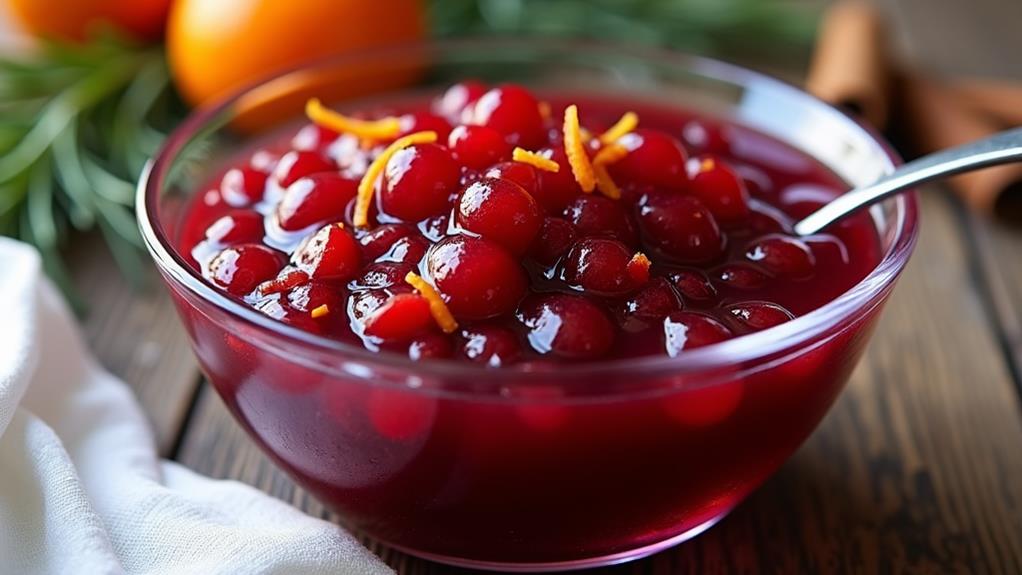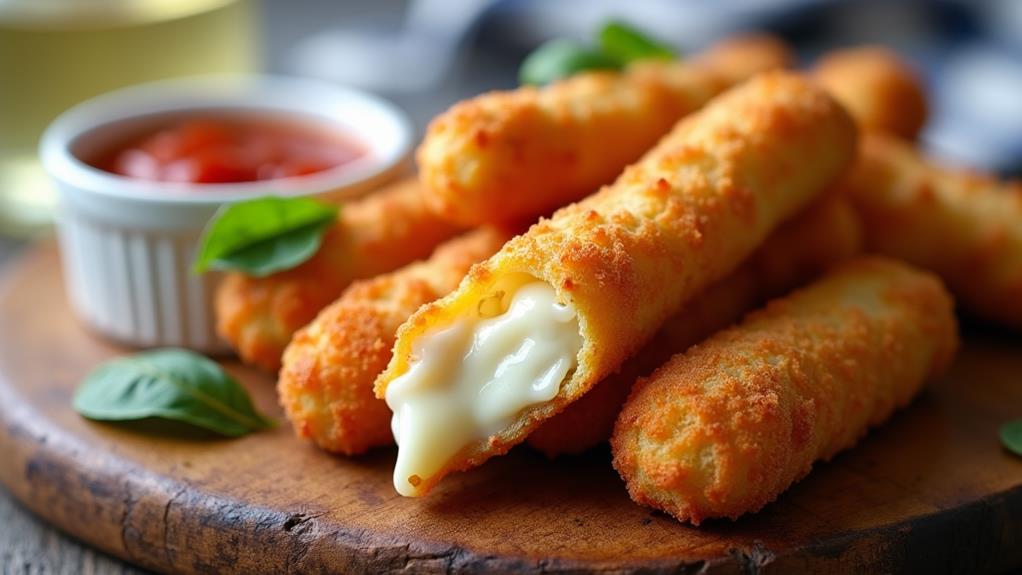To master the perfect sous vide steak, start by selecting a well-marbled cut, like ribeye, and chilling it to 41°F before vacuum sealing. Set your immersion circulator to 130°F for medium-rare or 141.8°F for medium-well, adjusting cooking time based on thickness. Season lightly before sealing, using 1% salt and 0.1% pepper by weight. After cooking, rest the steak for 10 minutes, then sear it in a 550-600°F skillet for no more than 2 minutes per side. This method ensures consistent doneness, tender texture, and optimal flavor. With practice, you'll fine-tune your technique and troubleshoot common issues for restaurant-quality results at home.
Understanding Sous Vide Steak Basics
Sous vide steak cooking is a game-changer for achieving perfectly cooked meat every time. This innovative method involves sealing your steak in an airtight bag and immersing it in a precisely controlled water bath. You'll find that this technique ensures optimal tenderness and flavor retention, giving you a perfectly cooked steak with every attempt.
To master the sous vide method, you'll need to understand the ideal temperatures for different levels of doneness. For a medium-rare steak, aim for 130°F (54°C), while medium-well requires 141.8°F (61°C). The cooking time will vary based on your steak's thickness and weight, so be sure to adjust accordingly.
Before you begin the sous vide process, it's crucial to sear your steak. This step creates a Maillard reaction, enhancing the flavor and texture with a rich, browned crust.
After searing, chill the steak to 41°F (5°C) before vacuum sealing to ensure even cooking and safety. Don't forget to season your steak with precisely measured salt (1% of the steak's weight) and pepper (0.1%) before sealing for optimal flavor infusion during cooking.
Choosing the Ideal Cut
Now that you're familiar with the sous vide basics, let's focus on selecting the perfect steak for your culinary adventure. When choosing a cut for your sous vide steak, opt for well-marbled ribeye. The intramuscular fat ensures optimal flavor and tenderness, enhancing juiciness during the precise temperature-controlled cooking process.
Look for steaks with consistent thickness, ideally between 1.5 to 2 inches, to guarantee even cooking throughout.
To elevate your sous vide steak experience, consider these innovative tips:
- Explore local, grass-fed options for a richer, more complex beefy flavor.
- Utilize a digital color meter to assess steak freshness by measuring its red hue.
- Experiment with different cuts, such as sirloin or tenderloin, to discover your preferred texture and flavor profile.
When selecting your steak, avoid cuts with excessive fat or gristle, as these can negatively impact the final texture.
Instead, choose bright red steaks that indicate freshness, steering clear of any showing browning or discoloration. By carefully selecting your cut, you'll set the foundation for a remarkable sous vide steak experience, allowing the precise temperature control to work its magic on your chosen cut.
Precision Temperature Control
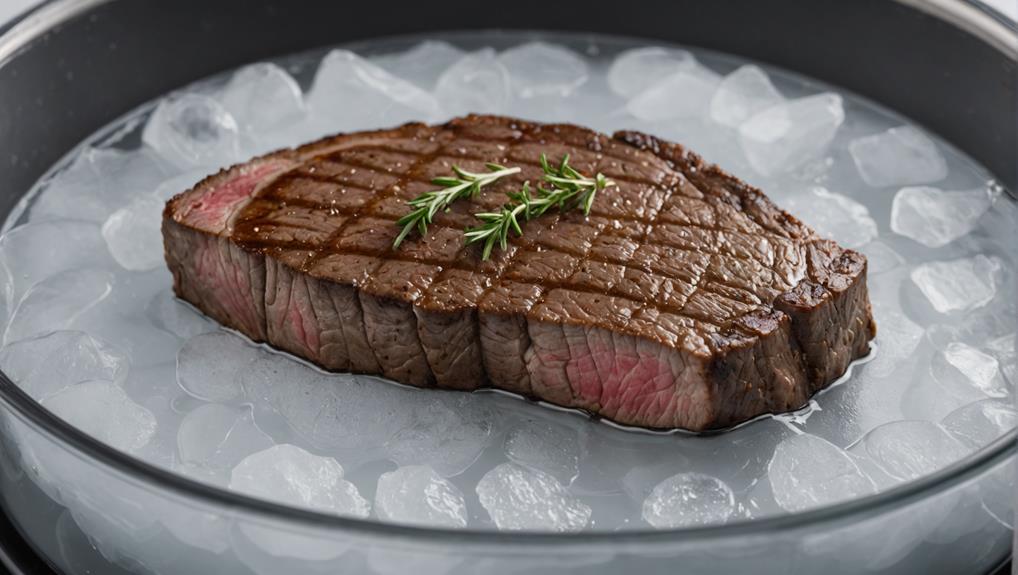
The heart of sous vide cooking lies in precision temperature control. With an immersion circulator, you'll achieve consistent results without the risk of over or undercooking.
You'll set your device to a specific temperature, typically ranging from 130°F for medium-rare to 141.8°F for medium-well. This ensures your steak reaches the desired doneness throughout.
Cooking times vary, but for optimal tenderness and flavor, a 1 lb. ribeye might take about 10 hours at 141.8°F. This prolonged, steady temperature allows for gradual protein breakdown, resulting in a more tender steak than traditional methods.
When preparing your steak, use a probe thermometer during the chilling phase. It's crucial to ensure the core temperature reaches 41°F before vacuum sealing.
This step is vital for food safety and quality.
Timing for Optimal Results
Precision in timing is crucial for achieving optimal results with sous vide steak. When you're aiming for that perfect medium-rare ribeye, set your sous vide cooker to 130°F (54°C) and let it work its magic for 1.5 hours. This ensures even cooking throughout the meat, giving you that tender, juicy texture you crave.
For those who prefer their steak more well-done, you'll need to adjust your approach. A medium-well steak at 141.8°F (61°C) requires about 10 hours of cooking time for a 1 lb. cut. This extended period allows the meat to become tender while retaining its moisture.
To achieve the best results with sous vide cooking, follow these key steps:
- Chill your seared steak to 41°F (5°C) before vacuum sealing
- Use a probe thermometer to monitor core temperature accurately
- Adjust cooking times based on steak thickness
Seasoning Techniques for Sous Vide
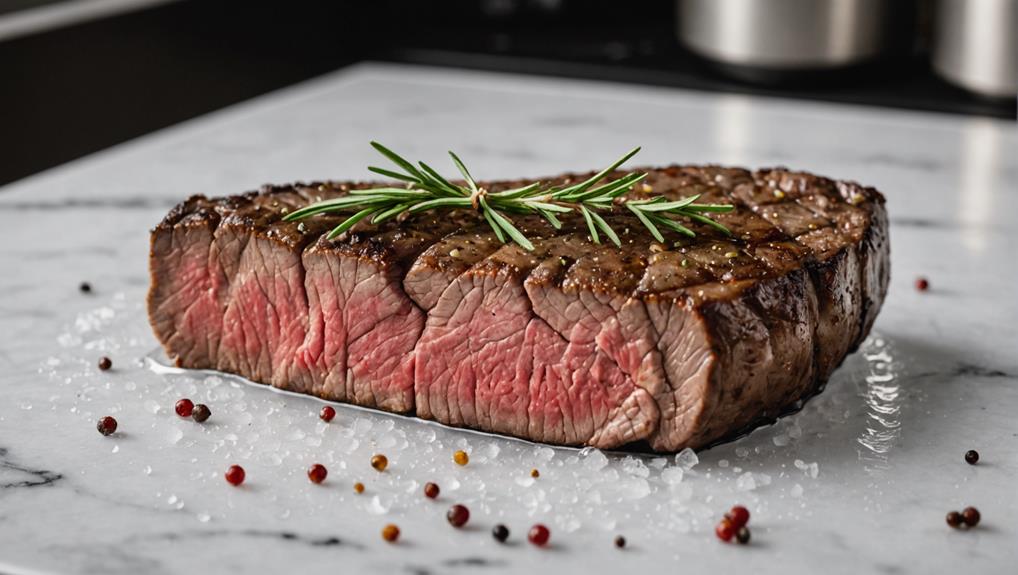
Seasoning techniques for sous vide steak are crucial for enhancing flavor without overpowering the meat's natural taste. To achieve the perfect balance, use a ratio of 1% salt and 0.1% pepper based on the steak's weight. This precise approach ensures you'll amplify the flavor without masking the beef's inherent qualities.
When experimenting with additional herbs or spices, remember to use only about 1/10 of the usual amount to avoid overwhelming the meat's taste.
For optimal results, season your steak before vacuum sealing. This allows the flavors to infuse deeply during the cooking process, resulting in a more robust and well-rounded taste profile.
Always vacuum seal your seasoned steak to prevent flavor loss and maintain moisture throughout the sous vide cooking process.
Don't be afraid to get creative with your seasoning blends. By experimenting with different combinations, you can craft unique flavor profiles that cater to your personal preferences.
This innovation in seasoning techniques can transform your sous vide steak from great to extraordinary, offering a customized culinary experience that showcases your skills and elevates your dining pleasure.
Mastering the Post-Cook Sear
When you're ready to sear your sous vide steak, timing and temperature are crucial factors to consider.
You'll want to heat your chosen tool, whether it's a cast-iron skillet or a grill, to a high temperature of around 550°F to 600°F for the best results.
Timing the Final Sear
The final sear is a crucial step in perfecting your sous vide steak. After allowing your steak to rest for 10 minutes post-sous vide cooking, you're ready to achieve that perfect crust.
To execute this step flawlessly, follow these key principles:
- Preheat your skillet or grill to 550-600°F
- Pat the steak dry thoroughly
- Sear each side for no more than 2 minutes
By adhering to these guidelines, you'll create an optimal Maillard reaction, resulting in a beautifully charred exterior while maintaining the steak's internal doneness.
The high heat ensures rapid crust formation, preventing overcooking of the perfectly cooked interior.
For an innovative twist, consider basting your steak with butter during the final sear. This technique adds richness and depth to the crust, elevating your steak's flavor profile.
Temperature and Tool Selection
Selecting the right tools and temperatures for searing your sous vide steak is crucial for achieving that perfect crust. To elevate your cooking method, aim for a searing temperature between 550 to 600°F (288 to 316°C). This high heat ensures a quick, effective sear that locks in flavor without overcooking the meat's interior.
Your choice of tools can make or break the searing process. Opt for a heavy-duty skillet or grill that can withstand intense heat. Cast iron pans are excellent for retaining and distributing heat evenly.
When it comes to oil, select one with a high smoke point, such as canola or grapeseed oil, to prevent burning and off-flavors.
Before searing, pat your steak dry to promote better browning. This step is essential for creating that coveted crust. As you sear, consider adding butter and aromatics like garlic or herbs to enhance the flavor profile.
Resting and Serving Your Steak
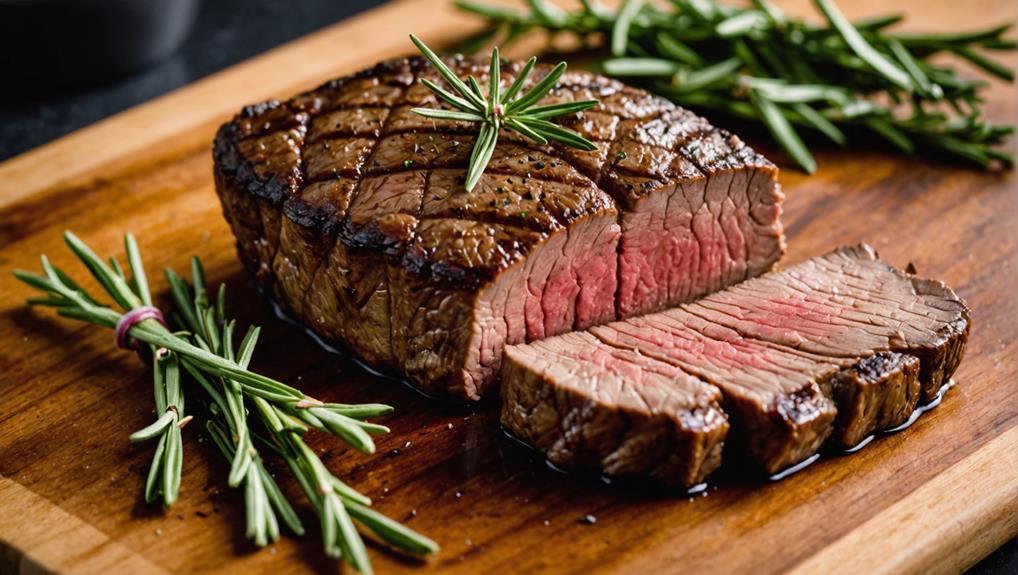
Patience plays a crucial role in the final stages of preparing your sous vide steak. After cooking, allow your steak to rest for 10 minutes, enabling the juices to redistribute throughout the meat. This resting period is crucial for optimal flavor and tenderness.
To expedite cooling before the final sear, employ a two-step process:
- Place the cooked steak in cold tap water for 10 minutes.
- Transfer it to an ice bath until the core temperature reaches 41°F (5°C).
- Pat the steak dry to promote better crust formation.
Once cooled, it's time for the final sear. Use a hot skillet with butter to achieve a desirable crust and enhance your steak's presentation. This step is essential for elevating your sous vide creation to restaurant-quality standards.
Remember to serve your steak immediately after searing to ensure it retains its warmth and optimal texture. By following these steps, you'll master the art of resting and serving your sous vide steak, impressing your guests with your culinary innovation and attention to detail.
The result? A perfectly cooked, visually stunning steak that's sure to delight even the most discerning palates.
Essential Sous Vide Equipment
Your sous vide journey begins with acquiring the right equipment. At the heart of this innovative cooking method is the immersion circulator, a device that heats and circulates water with precise temperature control. This ensures your steak cooks evenly and to perfection.
You'll also need a vacuum sealer and durable, heat-resistant bags to create an airtight environment for your meat, preserving flavors and moisture throughout the cooking process.
A large container or pot is essential for creating your water bath. A 12-quart size offers versatility for various cuts and quantities.
To keep your bagged steak submerged, consider optional accessories like sinker weights or clips. These simple tools can make a significant difference in achieving consistent results.
Troubleshooting Common Sous Vide Issues

Even with the right equipment, you may encounter challenges when cooking sous vide steak. To help you troubleshoot common issues, consider these helpful tips:
If your steak isn't reaching the desired doneness, verify that your water bath is set to the correct temperature and that your immersion circulator is functioning properly.
For overcooked, mushy steaks, reduce cooking time in future attempts to prevent excessive protein breakdown.
To ensure flavor-packed results:
- Adjust seasoning amounts before vacuum sealing
- Double-check for airtight seals to prevent water infiltration
- Pat the steak dry before searing for a perfect crust
When aiming for that coveted crust, use a sufficiently hot skillet or grill to create an effective Maillard reaction.
This step is crucial for achieving that restaurant-quality finish.
Frequently Asked Questions
How to Cook Perfect Steak Sous Vide?
You'll achieve a perfect sous vide steak by employing innovative techniques. Season, vacuum seal, and cook at precise temperatures. Chill before searing for optimal texture. Experiment with flavor infusion during sealing to elevate your culinary game.
What Is the Longest You Should Sous Vide Steak?
You've been watching that steak for hours, but when should you stop? For optimal results, don't exceed 48 hours. Consider sous vide timing and temperature carefully. You'll want to innovate within this window for the perfect texture.
Does Steak Get More Tender the Longer You Sous Vide?
You'll find sous vide benefits your steak's tenderness, but only to a point. Different steak cuts have optimal cooking times. After that, you won't see much improvement, and you might even compromise texture. Don't overdo it; precision is key.
Is It Better to Sear Steak Before or After Sous Vide?
You'll want to sear both before and after sous vide for the ultimate steak experience. Pre-searing locks in flavor, while post-searing restores the crust. This dual searing technique elevates your sous vide timing and searing skills to innovative heights.
Final Thoughts
You've now embarked on a culinary odyssey, mastering the art of sous vide steak like a modern-day Prometheus bringing the gift of perfectly cooked meat. Armed with precision, patience, and the right techniques, you'll transform ordinary cuts into extraordinary meals. Remember, practice makes perfect, and each steak is an opportunity to refine your skills. As you continue to experiment and learn, you'll find that sous vide cooking isn't just a method—it's a gateway to consistently achieving steak perfection that would make even the most discerning gourmands nod in approval.

